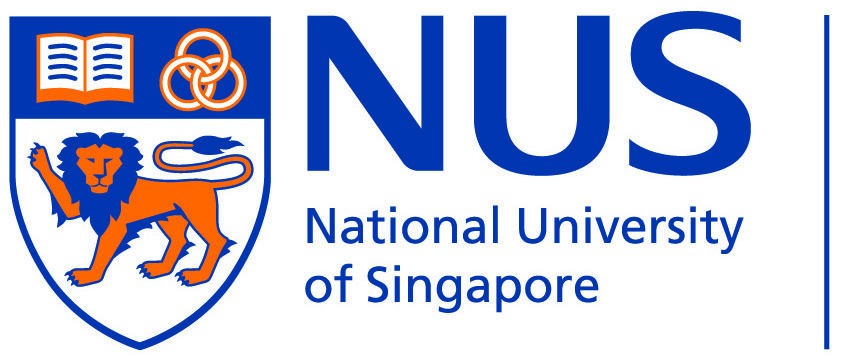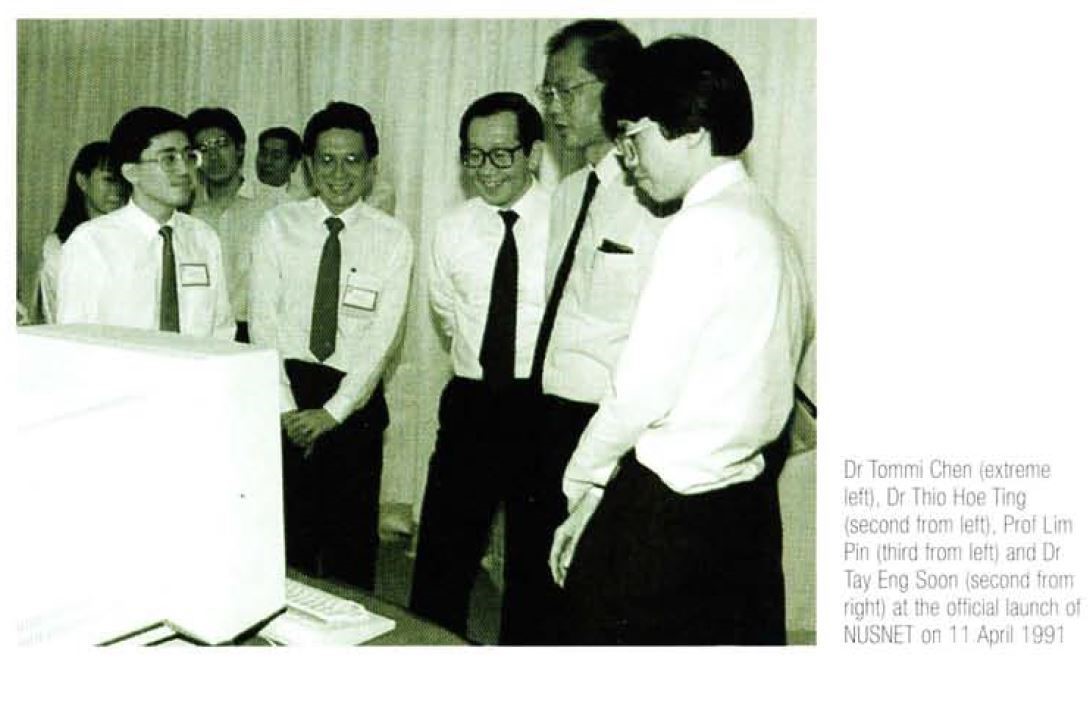NUS IT and the Origins of the Internet in Singapore
13 Oct 2020
By Jay Wee
I was but a new employee in NUS IT back then and in a presentation by the Head of Department, a PowerPoint slide was flashed on the screen:
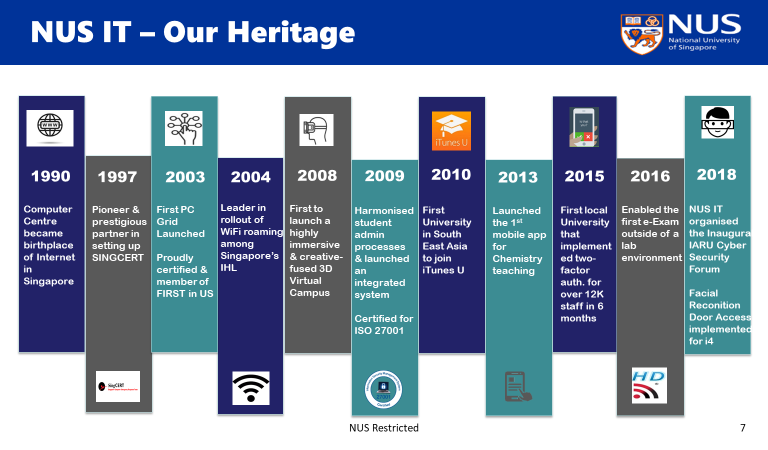
Wow! I didn’t know that my department had such an illustrious history! Filled with child-like awe, the first column at the corner of this drew my attention:
1990s: Computer Centre became birthplace of Internet in Singapore

What?!
Wait – wasn’t the Internet brought in by our government or some big telco at that point in time? What had NUS IT (also known as Computer Centre earlier) to do with it? Could there be more stories that were not told or known?
With that list of technical achievements, it would seem that NUS IT had always been on the forefront of breaking technological barricades in the education sector, but for reasons unknown, many of its achievements were little known.
For a person whose life (and the lack of) depended greatly on technology, plus being a newbie with insatiable curiosity, I just had to find out more about this, particularly the daring claim about being the birthplace of the Internet in Singapore.
Unfortunately, after some more research, I could not find information on Computer Centre being the birthplace of Internet in Singapore.
I was sorely disappointed, and almost thought I had hit a dead point. Yet, my curiosity lingered on.
The Tale of Two Articles and a Meeting
As fate would have had it, I came across two articles written and sent to us by Prof Bernard Tan Tiong Gie, a revered and respected physicist and a professor in NUS, titled: “Microcomputing in Singapore” published in Talk to Singapore Microcomputer Society, back in 13 April 2018; and “Origins of Internet in Singapore”, part of Envision Magazine published by Singapore Broadcasting Authority in 2000.
My eyes opened big and wide, and I felt like lady luck had smiled on me. I could not contain my excitement! Of the two articles one highlighted the general technology and development of microchips, while the other described and shed light on how Internet was first established in Singapore.
So, the claim that Computer Centre was the birthplace of the Internet in Singapore is true after all!
Like sleuths unravelling a mystery, this article piqued our curiosity enough and off we went to reach out to Prof Bernard Tan.
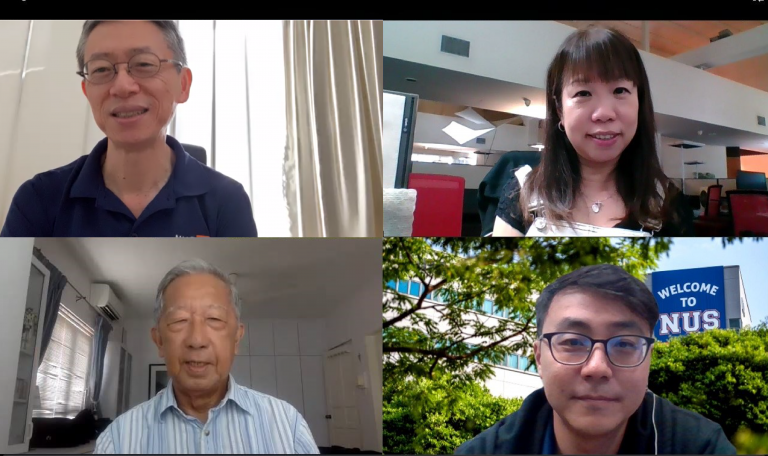
Zoom session with Prof Bernard Tan together with NUS IT CITO, Tommy Hor, Communications Head, Caren Chua and Jay Wee
Through the article and a zoom meeting, we found out that while the Internet in Singapore was largely and publicly made available through the telco SingTel back in 1994, the technology behind was in fact, implemented and made possible through the effort of many in NUS.
What an exciting discovery – so NUS was the birthplace and where Internet started in Singapore!
The Humble Origins
It all began with a simple recommendation report written by Prof Bernard Tan back in 1986 to Dr Thio Hoe Tong, Director of Computer Centre and Prof Lim Pin, Vice-Chancellor of NUS, upon his return to Singapore from an EDUCOM conference in Austin, Texas. At the EDUCOM conference, the focus was on ways to improve teaching, and recognition then that Internet had great potential as use for instructional purposes.
When he returned to Singapore, Prof Bernard Tan recommended that NUS joined EDUCOM and got NUS connected to BITNET (which stands for “Because It’s There Network”). The main intention of joining BITNET was to get connected to the academics and the “computer people” at the top universities all over the USA and Europe, largely for teaching and research purposes.
As Singapore was tucked in the middle of Asia, far from reputable universities then, the only way of communicating with others was either through snail mail or expensive landline phone calls. As early as that, Prof Bernard Tan already had the foresights of recognising that communications were pivotal to becoming world-class universities like Harvard, Cambridge or Princeton.
In Singapore nowadays, we are so readily connected with the rest of the world through Internet and Whatsapp, and it is all very convenient. In those days, we really felt that we were isolated and at the far end of the world. To get connected to the Internet was the one of the fastest ways to mitigate the isolation that we felt.
– Prof Bernard Tan
Prof Lim Pin too, recognised that we had to be part of the academic world of premium universities, and so he accepted the premises and recommendation immediately.
With BITNET, which already had a gateway to the Internet at that time, you could e-mail, do file transfers and even live messaging, but only through specific machines that had the root protocols. At that time when technology was a rarity, it cost a bomb to be able to do all that, unlike now. Also, the process was very manual and tedious as communications was configured through hardware rather than software.
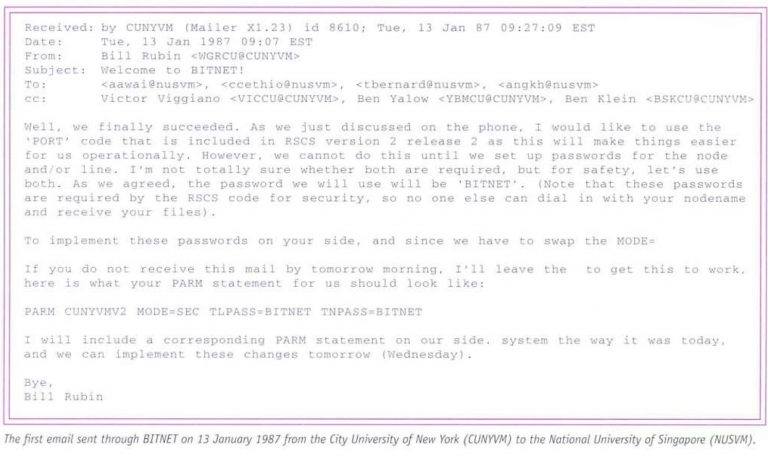
Through BITNET, Singapore was already connected 24/7 to the Internet and there was no need for the Internet Protocol suite TCP/IP, which was only available through Japan then.
With the ambition of expanding to the rest of Singapore, NUS decided to include more partners. However, at that time, nobody cared about the Internet because people did not appreciate what it meant to be connected and had no clue as to what capable of.
With a small group, NUS started TechNet (later known as Pacific Net after commercialisation) with NTU and a few companies from Science Park (who were in the EDUCOM conference as well) in the early 90s to further develop and work on the technology.
We had to solve funding problems but the most important factor of success was that the University was supportive of this initiative. Unlike typical projects, this was a ground-up initiative rather than a top-down one.
– Prof Bernard Tan
The Internet of the world today was never what it was intended to be, as it was originally built to serve as an internal communication tool for academic scientists and people in the educational sector. The turning point was the introduction of the World Wide Web protocol which extended its usage to a community that was previously restricted to those who had the tools, technology and knowledge beyond the layman. Steadily, WWW grew because many ideas were built on top of this platform like browser technology and search engines. And the rest, as the cliché would go, is history.
Breaking New Grounds and Driving Changes
Never to rest on our laurels, we have seen in more recent times how NUS has continued to venture into new technological grounds.
- NUS and StarHub established a 5G test laboratory in the first net-zero energy building in the School of Design and Environment and in Singapore;
- NUS became the first Institute of Higher Learning to implement WI-FI 6 technology throughout the entire campus; and that tripled the wireless speed for access to real-time applications
- NUS has made ready via Cloud on-demand provisioning for infrastructure capacity such as Internet bandwidth, system and storage resources to support volatile demands arising from those working from home, taking e-examination and participating in e-meetings, all due to COVID-19.
These ventures further exemplify NUS IT’s spirit of changing and transforming constantly in providing high speed and stable connections on reliable infrastructure to our researchers and students everywhere on and off campus. Anywhere, anytime and via any device.
Being the new “blood” in the organisation, I am proud to carry on with this adventurous spirit into the future, with this Internet accomplishment as my constant reminder of never to fear treading new grounds.
And if this Internet story intrigues you like it did us, we would strongly recommend you getting a first-hand account from Prof Bernard in his past articles, via the links below:
Prof Article 1 – Microcomputing_in_Singapore
Prof Article 2 – Origins of Internet in Singapore (colour) reduced
